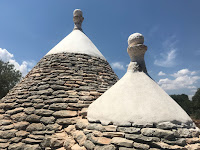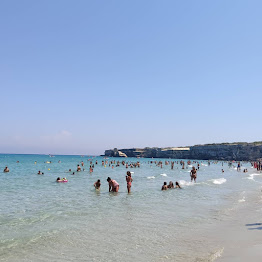Trullo....what is it?
What are those curious structures? why they have that cone shape? and those strange tips on top of different shapes?
These can be some of the questions that may come out when looking at this structures.
 Well, the Trullo is a very old rural building, They are built completely using dry stones, without any cement binders, but with only the limestone (typical of this area of Puglia) manually shaped and stacked one on top of the other one . The trullo is composed by an internal cone, built with squared stones, by a cavity filled with small stones and soil, and finally, by the external cone, with the famous "chiacarelle". The stones are worked and shaped by hand, one by one; in particular the chiancarelle are typically flat, conical and beveled on one side to recreate the external profile of the cone. It is a craft work that has been passed from generation to generation and only the expert hands of the master "trullaro" can perform this work.
Well, the Trullo is a very old rural building, They are built completely using dry stones, without any cement binders, but with only the limestone (typical of this area of Puglia) manually shaped and stacked one on top of the other one . The trullo is composed by an internal cone, built with squared stones, by a cavity filled with small stones and soil, and finally, by the external cone, with the famous "chiacarelle". The stones are worked and shaped by hand, one by one; in particular the chiancarelle are typically flat, conical and beveled on one side to recreate the external profile of the cone. It is a craft work that has been passed from generation to generation and only the expert hands of the master "trullaro" can perform this work.  The top of the trullo ends with a row of smaller chiancarelle that are blocked by the "pinnacle", an element made up of different elements and shapes. The history of the pinnacle is a bit mysterious, for someone they are a sort of "signature" of the master trullaro to distinguish his work, or simply a decorative element chosen by the trullo's owner, or, indeed, it leads back to a primitive magic symbology . Some of the typical forms, for example, the sphere, the pyramid or the disk, in ancient times were related to the sun worship.
The top of the trullo ends with a row of smaller chiancarelle that are blocked by the "pinnacle", an element made up of different elements and shapes. The history of the pinnacle is a bit mysterious, for someone they are a sort of "signature" of the master trullaro to distinguish his work, or simply a decorative element chosen by the trullo's owner, or, indeed, it leads back to a primitive magic symbology . Some of the typical forms, for example, the sphere, the pyramid or the disk, in ancient times were related to the sun worship.
Continuing with the description, at the base of the cone there are spaving slabs that act as gutters, to remove all the water that comes down from the cones. The vertical walls, always of drywall, can be very thick to bear the full weight of the cones. Typically the trullo is composed of the main cone, higher and central, and two lateral alcoves. Very often the fireplace can be found in one of the two alcoves.
 However, is possible to see trulli with only one cone or even with more cones communicating with each other with narrow walkways. Other trulli may have open hens, chickens and pigs were kept, or a lamia closed and communicating with the cones area.
However, is possible to see trulli with only one cone or even with more cones communicating with each other with narrow walkways. Other trulli may have open hens, chickens and pigs were kept, or a lamia closed and communicating with the cones area.
The trulli are UNESCO heritage, they can be found scattered in the Valle d'Itria in Puglia and Alberobello his the capital of Trulli!
I hope I got your attention and interest with these fancy structures, keep checking the blog for further updates.


Comments
Post a Comment